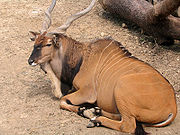
Giant eland
About this schools Wikipedia selection
SOS Children offer a complete download of this selection for schools for use on schools intranets. SOS Children is the world's largest charity giving orphaned and abandoned children the chance of family life.
| Giant Eland | |
|---|---|
 |
|
 |
|
| At the Houston Zoo | |
| Conservation status | |
|
Endangered
|
|
| Scientific classification | |
| Kingdom: | Animalia |
| Phylum: | Chordata |
| Class: | Mammalia |
| Order: | Artiodactyla |
| Family: | Bovidae |
| Subfamily: | Bovinae |
| Genus: | Taurotragus |
| Species: | T. derbianus |
| Binomial name | |
| Taurotragus derbianus Gray, 1847 |
|
The Giant Eland (Taurotragus derbianus also known as the Lord Derby Eland) is an open forest savannah antelope. It is found in Central African Republic, Sudan, Cameroon and Senegal. There are two subspecies: the endangered T. d. derbianus, found in Senegal's Niokolo-Koba National Park, and the low risk T. d. gigas, found in Central Africa.
Characteristics
Giant Eland are typically between 220-290 cm (7.3-9.6 ft) in length, stand approximately 150 to 175 cm (4.9 to 5.7 ft) at the shoulder, and weigh 440-900 kg (968- 1,980 lb). The smooth coat is reddish-brown to chestnut, usually darker in males than females, with several well-defined vertical white stripes on the torso. A crest of short black hair extends down the neck to the middle of the back, and is especially prominent on the shoulders. The slender legs are slightly lighter on their inner surfaces, with black and white markings just above the hooves. There are large black spots on the upper forelegs. The bridge of the nose is charcoal black, and there is an thin, indistinct tan-coloured chevron between the eyes. The lips are white, along with several dots along the jaw-line. A pendulous dewlap, larger in males then females, originates from between the jowls and hangs to the upper chest, with a fringe of hair on its edge. The tail is long, and ends with a dark tuft of hair. Both sexes have tightly spiralled horns, which are relatively straight. In males the horns form a wide "V" and can grow to 120 cm (4 ft) in length, slightly longer than on females.
Ontogeny and Reproduction
Gestation Period: 9 months
Young per Birth: 1
Weaning: After 6 months.
Sexual Maturity: Females at 15-36 months, males at 4-5 years.
Life span: Up to 25 years.
Ecology and Behaviour
Primarily nocturnal, Giant Elands are highly nomadic, with large home ranges and seasonal migration patterns. During the day, herds often rest in sheltered areas. A gregarious species, Giant Eland herds usually consist of twenty or more animals and do not disband during the wet season, suggesting that social rather than ecological factors are responsible for herding. There is no evidence of territoriality, and males rarely display aggression, even during the breeding season. Giant Eland are alert and wary, making them difficult to approach and observe. They move quickly, running at over 70 kmph (42 mph), and despite their size are exceptional jumpers, easily clearing heights of 1.5 m (5 ft). Giant Eland live in open forest and savannah where they eat grass, leaves, and branches. Their primary predators are the Lion and Spotted Hyena.
Distribution
Broad-leafed savanna and glades in two isolated pockets in central and western Africa.

